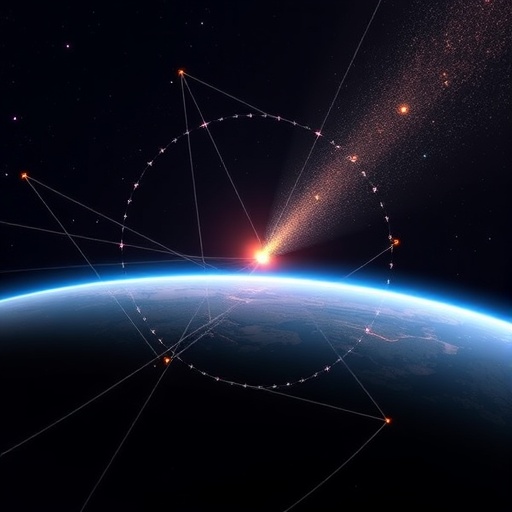The Center for Artificial Intelligence Innovation (CAII) at the National Center for Supercomputing Applications (NCSA), affiliated with the University of Illinois at Urbana-Champaign, has embarked on a significant endeavor with NASA’s backing. The generous funding of $1 million will bolster efforts surrounding the Euclid space mission. The mission’s primary aim is to delve into the enigmatic realms of dark matter and dark energy, two of the most elusive components of the cosmos that govern the universe’s structure and evolution.
As part of their collaboration with NASA, CAII will play a pivotal role in developing an open-source deep learning framework aimed at processing images captured by the Euclid spacecraft. This undertaking is spearheaded by Principal Investigator Xin Liu, who emphasizes the critical nature of this research. A primary hurdle in the analysis of data generated by Euclid is the phenomenon of blended galaxies. Overlapping images can obscure distinct sources of galactic information, making it challenging to derive accurate astrophysical measurements. The blending of galaxies is particularly problematic in areas such as photometry, redshift estimation, and galaxy morphology, as it introduces biases that can lead to significant inaccuracies in scientific interpretations.
Deep learning, specifically through a tool known as Detection, Instance Segmentation and Classification with Deep Learning (DeepDISC), is revolutionizing the approach to identifying celestial objects. This innovative tool harnesses machine learning techniques to enable a more accurate detection of stars and galaxies. Liu and his team will leverage DeepDISC within the framework of the Euclid mission to not only enhance the accuracy of galaxy identification but also to quantify the uncertainties associated with their predictions. This dual approach promises to significantly improve the reliability of data analysis, ensuring that researchers can draw trusted conclusions from their findings.
Liu articulates the importance of addressing blended sources in Euclid’s data analysis, citing that overcoming this challenge is essential for the integrity of the mission’s scientific outputs. The implications of this research extend beyond Euclid itself; the techniques developed can be adapted for other ambitious space exploration projects, most notably the Vera C. Rubin Observatory. With its anticipated first light occurring later this year, the observatory stands to benefit from advancements in deblending images both from ground-based telescopes and those deployed in space.
The research team is bolstered by a collaborative spirit, with critical contributions from co-principal investigators such as Vlad Kindratenko, Director of CAII, along with Astronomy Professor Yue Shen and Computer Science Professor Yuxiong Wang. Their distinct expertise in computational infrastructure, data analysis methodologies, and machine learning act as a strong foundation for this interdisciplinary project. Each member brings a wealth of knowledge that enhances the scientific rigor and innovative spirit of the mission.
Wang emphasizes that the advancements in computer vision and artificial intelligence are leading to foundational models that redefine our understanding of visual information through natural images. The current phase in AI research represents a thrilling opportunity to adapt these powerful models toward unraveling the mysteries of the universe. In an age where AI is becoming increasingly capable, its integration into fields like astrophysics showcases the potential for transformative discoveries and enhances our collective understanding of fundamental cosmic principles.
The CAII’s initiative reflects broader trends in interdisciplinary collaboration, showcasing how artificial intelligence can intersect with scientific inquiry in profound ways. As AI methodologies evolve and improve, their application to space exploration promises unprecedented advancements in our quest for knowledge. The focus on deep learning and its ability to sort through complex datasets will be vital in maximizing the scientific return of missions like Euclid, ensuring that the wealth of information collected translates into significant scientific insights.
Moreover, the interdisciplinary nature of the project heralds a new era of scientific research where collaboration across different fields is not just beneficial but necessary. The integration of knowledge from AI, computer science, and astrophysics underscores the importance of blending disciplines to address the multifaceted challenges presented by complex datasets in space exploration.
As the Euclid mission prepares to launch, the work being done by CAII serves as a beacon of innovation, particularly in the realm of AI applications in astrophysics. The developments achieved through deep learning frameworks have the potential to redefine how scientists engage with astronomical data, paving the way for future missions and research endeavors in understanding the dark universe.
In conclusion, the collaboration between CAII and NASA represents an exciting juncture in the intersection of artificial intelligence and astrophysics. Through substantial investment, innovative methodologies, and a commitment to scientific excellence, this initiative will not only enhance the accuracy of data analysis in the Euclid mission but also contribute to the broader dialogue about dark matter and dark energy, ultimately aiming to unlock new dimensions of understanding within the universe’s vast expanse.
Subject of Research: Analysis of dark matter and dark energy using AI in the Euclid mission
Article Title: CAII Harnesses AI for the Euclid Mission to Explore the Dark Universe
News Publication Date: [Insert publication date]
Web References: [Provide relevant URLs]
References: [List citations if necessary]
Image Credits: [Provide credit if applicable]
Keywords
AI, dark matter, dark energy, Euclid mission, deep learning, NCSA, CAII, astrophysics, Vera C. Rubin Observatory, machine learning, blended galaxies, data analysis.




